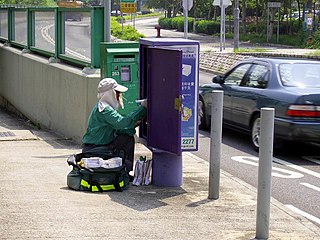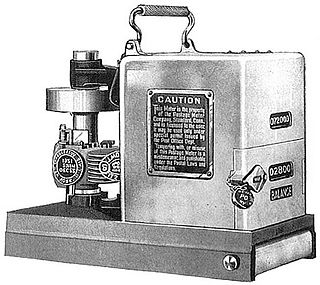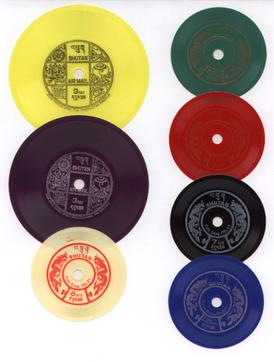
Mr. ZIP, informally "Zippy", is a cartoon character used in the 1960s by the United States Post Office Department, and later by its successor, the United States Postal Service, to encourage the general public to include the ZIP Code in all mailings.

Mr. ZIP, informally "Zippy", is a cartoon character used in the 1960s by the United States Post Office Department, and later by its successor, the United States Postal Service, to encourage the general public to include the ZIP Code in all mailings.

The USPS has described the origin of Mr. ZIP as follows: [1] [2] [3]
Mr. ZIP was based on an original design by Howard Wilcox, son of a letter carrier and a member of the Cunningham and Walsh advertising agency, for use by a New York bank in a bank-by-mail campaign. Wilcox's design was a child-like sketch of a postman delivering a letter. The figure was used only a few times, then filed away. Later, AT&T acquired the design and made it available to the Post Office Department at no cost. ... Miami-based Post Office Department artist Joe Lawrence retained the face but sharpened the limbs and torso and added a mail bag. The new figure, who Lawrence had dubbed Mr. ZIP, was unveiled at a convention of postmasters in October 1962.
The character's original name had been Mr. P.O. Zone, but was changed to Mr. ZIP along with the new term "ZIP code." [4]

The Post Office had little difficulty in getting mass mailers to use the ZIP Code as it could make its inclusion a condition for receiving preferential mailing rates and soon did. However, there was some resistance by the general public, members of whom would mail items without ZIP Code, almost invariably at the full rate for First Class Mail, which by regulation had to be delivered if at all possible and feasible. This was particularly true of older mailers. Mr. ZIP was the Post Office's answer to this, apparently intended to teach small children to always use the ZIP Code as they got older and also to encourage their parents and grandparents to do so.
Mr. ZIP is a caricature of a mail carrier, wide-eyed and drawn with his letter bag trailing him in such a way as to imply his travelling at extreme speed, and sometimes holding on to his hat with his free hand. His limbs were very thin, almost like those of a stick figure. He was particularly used on posters promoting ZIP Code use.
Mr. ZIP appeared on the selvage (non-postally valid areas) of stamp panes (more commonly called "sheets") for many stamp issues, beginning with the 5 cent Sam Houston stamp issued January 10, 1964, [5] although the 5¢ Battle of the Wilderness stamp of May 5, 1964, is sometimes listed as the "first" because it appears earlier in most stamp catalogs due to its inclusion in a five-issue Civil War series. He also appeared on non-postally-valid labels inside, or on the cover of, stamp booklets. Stamp collectors sometimes collect the corner block of four stamps with the part of the selvage bearing Mr. ZIP; these are called "ZIP blocks". As the Post Office promoted the use of ZIP codes, Mr. ZIP was also displayed in post offices as a 4.5-foot tall plywood figure. [6]

Mr. ZIP was featured prominently alongside the band the Swingin' Six in a televised Post Office-sponsored variety show. The songs included lyrics such as, "Meet the fellow called Mr. ZIP. What he can do for you will make you really flip. So if you have any further postal demands, we're gonna leave you in his hands." [7] [8]
A corresponding character named Mrs. ZIP was used in local parades and a Mrs. ZIP beauty pageant. [7] The National Postal Museum does not have documentation about her origins. [9]
The character was largely phased out by the late 1970s, but the Post Office retained rights to the copyrighted figure. Mr. ZIP appeared in the blank selvage of United States stamps until January 1986. [1]
The Post Office re-introduced Mr. ZIP to stamps in 2013, celebrating the 50th anniversary of the ZIP Code system. [10]

A postage stamp is a small piece of paper issued by a post office, postal administration, or other authorized vendors to customers who pay postage. Then the stamp is affixed to the face or address-side of any item of mail—an envelope or other postal cover —which they wish to send. The item is then processed by the postal system, where a postmark or cancellation mark—in modern usage indicating date and point of origin of mailing—is applied to the stamp and its left and right sides to prevent its reuse. Next the item is delivered to its addressee.

The United States Postal Service (USPS), also known as the Post Office, U.S. Mail, or Postal Service, is an independent agency of the executive branch of the United States federal government responsible for providing postal service in the U.S., including its insular areas and associated states. It is one of the few government agencies explicitly authorized by the Constitution of the United States. The USPS, as of 2021, has 516,636 career employees and 136,531 non-career employees.

The mail or post is a system for physically transporting postcards, letters, and parcels. A postal service can be private or public, though many governments place restrictions on private systems. Since the mid-19th century, national postal systems have generally been established as a government monopoly, with a fee on the article prepaid. Proof of payment is usually in the form of an adhesive postage stamp, but a postage meter is also used for bulk mailing.

The United States Post Office Department was the predecessor of the United States Postal Service, in the form of a Cabinet department, officially from 1872 to 1971. It was headed by the postmaster general.

A postal code is a series of letters or digits or both, sometimes including spaces or punctuation, included in a postal address for the purpose of sorting mail.

A ZIP Code is a system of postal codes used by the United States Postal Service (USPS). Introduced on July 1, 1963, the basic format consisted of five digits. In 1983, an extended ZIP+4 code was introduced; it included the five digits of the ZIP Code, followed by a hyphen and four digits that designated a more specific location.
Robert Aurand Moon, sometimes called "Mr. ZIP", is considered the father of the ZIP Code or Zone Improvement Plan, a mechanism to route mail in the United States.
Canada Post Corporation, trading as Canada Post, is a Crown corporation that functions as the primary postal operator in Canada. Originally known as Royal Mail Canada, rebranding was done to the "Canada Post" name in the late 1960s, even though it had not yet been separated from the government. On October 16, 1981, the Canada Post Corporation Act came into effect. This abolished the Post Office Department and created the present-day Crown corporation that provides postal service. The act aimed to set a new direction for the postal service by ensuring its financial security and independence.

Postal service in the United States began with the delivery of stampless letters whose cost was borne by the receiving person, later encompassed pre-paid letters carried by private mail carriers and provisional post offices, and culminated in a system of universal prepayment that required all letters to bear nationally issued adhesive postage stamps.

Dead letter mail or undeliverable mail is mail that cannot be delivered to the addressee or returned to the sender. This is usually due to lack of compliance with postal regulations, an incomplete address and return address, or the inability to forward the mail when both correspondents move before the letter can be delivered. Largely based on the British model that emerged in the late eighteenth century, many countries developed similar systems for processing undeliverable mail.

The postage stamps and postal system of the Confederate States of America carried the mail of the Confederacy for a brief period in American history. Early in 1861 when South Carolina no longer considered itself part of the Union and demanded that the U.S. Army abandon Fort Sumter, plans for a Confederate postal system were already underway. Indeed, the Confederate Post Office was established on February 21, 1861; and it was not until April 12 that the American Civil War officially began, when the Confederate Army fired upon US soldiers who had refused to abandon the fort. However, the United States Post Office Department continued to handle the mail of the seceded states as usual during the first weeks of the war. It was not until June 1 that the Confederate Post Office took over collection and delivery, now faced with the task of providing postage stamps and mail services for its citizens.
Poste restante, also known as general delivery in North American English, is a service where the post office holds the mail until the recipient calls for it. It is a common destination for mail for people who are visiting a particular location and have no need, or no way, of having mail delivered directly to their place of residence at that time.
An address is a collection of information, presented in a mostly fixed format, used to give the location of a building, apartment, or other structure or a plot of land, generally using political boundaries and street names as references, along with other identifiers such as house or apartment numbers and organization name. Some addresses also contain special codes, such as a postal code, to make identification easier and aid in the routing of mail.

India Post is a government-operated postal system in India, part of the Department of Post under the Ministry of Communications. Generally known as the Post Office, it is the most widely distributed postal system in the world. Warren Hastings had taken initiative under East India Company to start the Postal Service in the country in 1766. It was initially established under the name "Company Mail". It was later modified into a service under the Crown in 1854 by Lord Dalhousie. Dalhousie introduced uniform postage rates and helped to pass the India Post Office Act 1854 which significantly improved upon 1837 Post Office act which had introduced regular post offices in India. It created the position Director General of Post for the whole country.

The system for mail delivery in the United States has developed with the nation. Rates were based on the distance between sender and receiver in the early years of the nation. In the middle of the 19th century, rates stabilized to one price regardless of distance. Rates were relatively unchanged until 1968, when the price was increased every few years by a small amount. Comparing the increases with a price index, the price of a first class stamp has been steady. The logo for the Post Office Department showed a man on a running horse, even as the railroads and then motorized trucks and airplanes moved mail. In 1971, the Post Office became the United States Postal Service, with rates set by the Postal Regulatory Commission, with some oversight by Congress. Air mail became standard in 1975. In the 21st century, prices were segmented to match the sorting machinery in use; non-standard letters required slightly higher postage.

A postage meter or franking machine is a mechanical device used to create and apply physical evidence of postage to mailed items. Postage meters are regulated by a country's postal authority. A postage meter imprints an amount of postage, functioning as a postage stamp, a cancellation and a dated postmark all in one. The meter stamp serves as proof of payment and eliminates the need for adhesive stamps.

Owney, was a terrier mix adopted in the United States as a postal mascot by the Albany, New York, post office about 1888. The Albany mail professionals recommended the dog to their Railway Mail Service colleagues, and he became a nationwide mascot for nine years (1888–1897). He traveled over 140,000 miles throughout the 48 contiguous United States and around the world as a mascot of the Railway Post Office and the United States Postal Service. He was the subject of commemorative activities, including a 2011 U.S. postage stamp.

The first postage stamps of Bhutan were issued in 1962, the same year that the first motorable road was opened. Before that there was a mail delivery system in place for official mail using mail runners, and between 1955 and 1962 revenue stamps were accepted as payment for internal mail. With the opening up of Bhutan in the early 1960s, a formal postal system was introduced. The American entrepreneur Burt Todd assisted in establishing a postage stamp program in the country and Bhutan became known for the unusual designs and materials of its stamps which were chosen by Todd specifically to attract attention. With the assistance of the Indian postal advisor Dr. K. Ramamurti, who was in Bhutan from 1964 to 1968, a proper postal organization and infrastructure was set up under the leadership of a young Bhutanese officer Mr. Lam Penjor, who became the Director of the Department of Posts and Telegraphs.

The 1930 Graf Zeppelin stamps were a set of three airmail postage stamps, each depicting the image of the Graf Zeppelin, issued by the United States Post Office Department in 1930, exclusively for delivery of mail carried aboard that airship. Although the stamps were valid for postage on mail sent on the Zeppelin Pan American flight from Germany to the United States, via Brazil, the set was marketed to collectors and was largely intended to promote the route. 93.5% of the revenue generated by the sale of these stamps went to the Zeppelin Airship Works in Germany. The Graf Zepplin stamps were issued as a gesture of goodwill toward Germany. The three stamps were used briefly and then withdrawn from sale. The remainder of the stock was destroyed by the Post Office Department. Due to the high cost of the stamps during the Great Depression, most collectors and the general public could not afford them. Consequently, only about 227,000 of the stamps were sold, just 7% of the total printed, making them relatively scarce and prized by collectors.
Despite the success and popularity of Mr. Zip with the younger generation, the enthusiasm was not shared by all. Several groups had a negative view of the new campaign and resented the implementation of ZIP codes by Mr. Zip as a burden in their daily lives.
On January 10, 1964, Mr. Zip first appeared in the selvage of a stamp sheet honoring Texas icon Sam Houston.